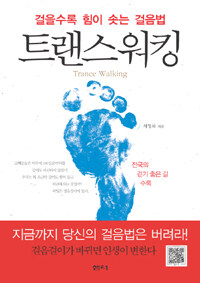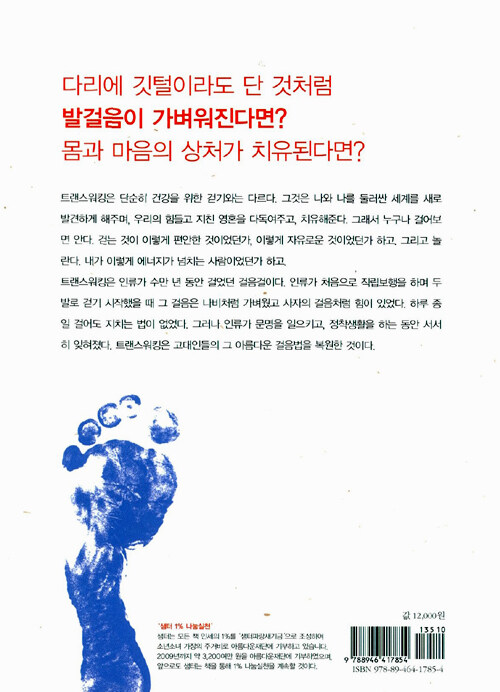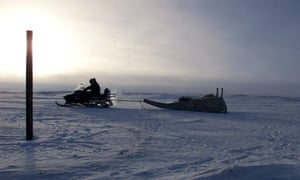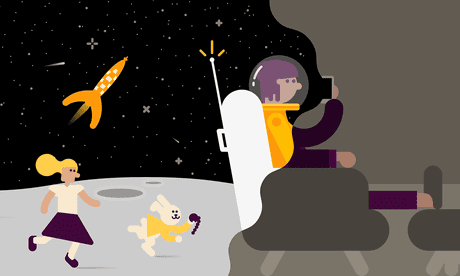트랜스워킹 - 걸을수록 힘이 솟는 걸음법

서정록(저자) | 샘터사 | 2010-11-30


-------------

반양장본 | 236쪽 | 152*223mm (A5신) | 330g | ISBN : 9788946417854
------------------
Sales Point : 315

--------------

한때 마사이족의 걷기가 인기를 끌면서 ‘마사이워킹’이 유행했다. 그다음엔 힘차게 팔을 흔들며 걷는 ‘파워워킹’이 인기를 끌었다. 그리고 지금은 전국 둘레길로 사람들이 몰리면서 ‘트레일워킹’이 유행이다. 저자는 인류가 수만 년 전부터 걸어온 고대걸음법을 그동안 ‘아메리카 인디언 걸음법’ ‘원주민 걸음법’ ‘수렵시대 인류의 걸음법’ ‘고대인의 걸음법’ 등등의 이름으로 사람들에게 소개해왔다.
매년 20여만 명이 장장 800킬로미터에 이르는 스페인 북부의 산티아고 순례길을 찾는다고 한다. 그만큼 힘들다는 얘기다. 그럼에도 이 길이 이렇게 세계적으로 유명해진 데에는 전 세계적으로 6,000만 부나 팔린 파울로 코엘료의 소설 《순례자》 덕분이기도 하다. 산티아고 순례길을 걸으며 사람들은 삶을 되돌아보게 되고 잃어버린 자아와 마주하면서 자신도 모르게 눈물을 흘리며 행복감을 느끼게 된다. 이런 것이 바로 걸으면서 느끼는 트랜스 현상이다.
저자는, 자기도 모르는 사이에 트랜스 상태에 빠지면 걷는 속도를 늦추고 천천히 걸으면서 걷기명상을 하라고 말한다. 일단 트랜스 상태에 들면 언제든지 걷기명상으로 모드를 바꿀 수 있으며, 명상 상태가 되면 언제든 의식을 확장해 주변사물에 다가갈 수 있으며, 원한다면 내면으로 향할 수도 있다. 그래서 자신을 돌아보고 지난 일을 성찰할 수 있다. 그러면 어느새 나와 나를 둘러싼 세계를 새로 발견하게 되고, 힘든 영혼의 상처가 치유되는 행복한 체험을 하게 될 것이다.
-------------

프롤로그 _ 기적은 무릎을 구부리고 걷는 데 있다
나를 내려놓는 걸음법 | 나비처럼 가볍고 사자처럼 힘 있는 걸음걸이
1부 고대인들의 걸음걸이에 담긴 비밀
1. 하룻밤에 100킬로미터를 달리는 사람들
인디언들의 특별한 전령문화 | 푸에블로 인디언들의 반란 | 태초에 신도 두 발로 달렸다 | 인간의 한계를 시험하는 달리기 경주
2. 인디언들의 걸음걸이
사냥꾼처럼 유연하고 민첩하게 | 대지가 스프링처럼 밀어올린다 | 발바닥에 군살이 없는 원주민들
3. 신비로운 고대인들의 트랜스 자세
왜 고대인들은 무릎을 구부렸을까 | 자연과 하나 되는 신성한 걸음걸이
4. 트랜스란 무엇인가
내면이 강물처럼 춤추고 | 몸 전체가 하나의 리듬으로 | 몸과 마음에 힐링이 일어난다
2부 걷는 것만으로도 행복해지는 트랜스워킹
5. 트랜스 워킹의 원리
복식호흡을 하라 | 척추가 유연하게 움직이게 하라 | 발걸음이 바람처럼 가벼워지게 하라 | 몸 전체가 하나가 되어 움직이게 하라 | 전신이 깨어나 춤추게 하라 | 걷는 동안 자연과 우주의 신비를 경험하라
6. 트랜스 워킹의 기본자세
양발은 고관절 넓이만큼 벌린다 | 무릎은 약간 구부린다 | 발끝은 15도로 벌어지게 | 발바닥 전체를 공 굴리듯 고루 사용하라 | 척추를 똑바로 펴라 | 팔다리로 걷지 말고 몸통으로 걸어라 | 시야를 멀리 둬라 | 손바닥을 가볍게 펴라 | 숨쉬기는 복식호흡으로 편안하게
7. 트랜스 워킹으로 틀어진 자세 바로잡기
발바닥의 족궁은 신이 인간에게 내린 놀라운 선물 | 무릎을 쭉 펴고 서거나 걷는 자세 | 양쪽 발끝이 바깥으로 크게 벌어진 자세 | 안짱걸음과 팔자걸음 | 평발 | 상체가 앞으로 쏠린 꾸부정한 자세 | 배를 내밀고 상체를 뒤로 젖히고 걷는 자세 | 어깨를 뒤로 젖히고 가슴을 내미는 자세 | 한쪽 어깨가 치켜 올라간 자세 | 한쪽 고관절이 올라간 자세 | 걷는 것만으로 자세가 돌아오지 않으면
8. 걸으면 심장이 하나 더 생긴다
잃어버린 청춘을 되찾으려면 | 트랜스 워킹은 건강하게 오래 사는 묘약 | 발을 자주 만져줘라 | 하루 중 언제 걷는 게 가장 좋을까 | 걸을 때 숨이 많이 차다면
9. 트랜스 워킹에 적합한 신발 고르기
가벼워야 한다 | 발에 잘 맞고 통풍이 잘돼야 한다 | 뒷굽이 없거나 낮아야 한다 | 신발 밑창의 굴신이 자유로워야 한다 | 바닥에 적당한 쿠션이 있어야 한다
3부 걷기명상
10. 트랜스 워킹이 쿤달리니 에너지를 깨운다
제1차크라가 인생을 바꾼다 | 쿤달리니는 스트레스를 제거하는 메커니즘 | 트랜스 워킹의 선물, 쿤달리니
11. 나의 의식을 우주로 확장하기
걷기명상에 들어가려면 | 잡념과 상념을 가라앉지 않는다면 | 의식을 확장하라 그리고 손으로 만져보고 냄새를 맡아보라
에필로그 _ 걷기는 자연 속 수많은 생명과의 만남
부록 전국의 걷기 좋은 길 : 트랜스워킹 연습하기 좋은 길 | 여행 삼아 걷기 좋은 길
---------------


P.37 : 일찍이 수우족의 대추장이었던 ‘한 개의 뿔’은 젊은 시절 대평원의 달리기경주에서 그를 능가할 자가 없었다고 한다. 그들에게 달리기는 신성한 행위였던 것이다. 확실히 그들의 달리기 문화에는 현대인들이 따라갈 수 없는 어떤 차원의 벽이 있는 것처럼 느껴진다. 현대인들이 미처 생각지 못하는 깊은 문화적, 영적 배경이 있음에 틀림없다. 그들의 기적은 오늘날까지 이어져 멕시코 북부지역에 사는 타라후마라족은 해마다 모든 성인 남자와 여자가 200킬로미터를 달리는 의례를 행한다고 한다. 그들은 스스로를 ‘라라무리(raramuri)’라 부르는데, ‘맨발로 달리는 자’라는 뜻이다. 나는 오랜 공부와 탐구 끝에 그들이 그렇게 달릴 수 있었던 것은 그들의 독특한 ‘걸음걸이’에 있다는 것을 알게 되었다. 그렇다면 이런 놀라운 달리기 문화를 낳은 그들의 걷기는 어떤 것일까? 도대체 어떤 방식으로 걸었기에 몇 시간씩 지치지도 않고 바람처럼 날쌔게 달릴 수 있었던 것일까? (‘하룻밤에 100킬로미터를 달리는 사람들’ 중에서)

P.49~50 : 현대인들은 발바닥에 군살이 많은 편이다. 그러나 하루에 3만 보를 걷는다는 마사이족이나 다른 원주민들의 발바닥에는 군살이 없는 것으로 알려져 있다. 이런 현상은 전통 시대 아메리카 인디언들도 마찬가지였을 것이다. 군살은 피가 제대로 공급되지 않을 때 생긴다. 반대로 군살이 없다는 것은 그만큼 혈액순환이 잘된다는 것을 의미한다. 현대인들이 발바닥에 피가 잘 순환되지 않는 비정상적인 걸음을 걷는 반면, 원주민들은 발바닥 전체에 하중이 고루 분산되게 걸음을 걷기 때문일 것이다. 발바닥에 혈액이 제대로 순환되지 않으면 조금만 걸어도 종아리가 퉁퉁 붓는 등 여러 가지 질병을 초래한다. 배와 손발이 찬 것도 그런 증상들 중의 하나이다. 반대로 발바닥에 혈액순환이 잘되면 몸 전체가 따뜻해진다. 자연히 몸에 생기가 넘치고, 발걸음이 가벼울 수밖에 없다. (‘인디언들의 걸음걸이’ 중에서)

P.64 : 현대인들은 대부분 무릎을 쭉 펴고 걷는다. 이런 걸음은 허리와 목을 긴장시키고, 뇌를 긴장시킨다. 현대인들의 삶의 패턴이 “빠르게! 빠르게!”를 외치는 것은 이렇듯 뇌가 늘 상기되어 있는 것과 무관하지 않다. 현대인들의 각종 스트레스와 질병 역시 마찬가지다. 그것을 다스리는 좋은 방법은 무릎을 약간 구부리고 엄지발가락을 사용해 앞으로 차고 나가며 걷는 것이다. 그러면 언제 그랬냐는 듯이 호흡이 편안해지고 마음이 고요해지며, 심신이 자유로워진다. (‘신비로운 고대인들의 트랜스 자세’ 중에서)

------------

저자 : 서정록
저자파일
최고의 작품 투표
신간알리미 신청
 최근작 : <인라케시 알라킨>,<우리가 이 세상에 온 이유>,<마음을 잡는 자, 세상을 잡는다> … 총 25종 (모두보기)
최근작 : <인라케시 알라킨>,<우리가 이 세상에 온 이유>,<마음을 잡는 자, 세상을 잡는다> … 총 25종 (모두보기) 소개 :
소개 : 경기도 평택에서 태어나 서울대학교 철학과와 동 대학원을 졸업했다. 한살림모임 창립멤버이다. 문화사를 중심으로 고대 동북아시아 역사에 관한 책을 쓰고 있으며, 2000년 이후에는 아메리카 인디언들과 제3세계 원주민들의 문화와 영성에 대해 공부해오고 있다.
그에게는 두 번의 큰 열림이 있었다고 한다. 첫 번째는 무위당 장일순 선생님을 만난 것이다. 무위당 선생님을 만나고 나서 세상에 대한 모든 번뇌와 갈등이 얼음 녹듯이 사라졌으며, 스승의 존재가 얼마나 중요한 것인지 깨달았다고 한다. 두 번째는 아메리카 인디언들에 대해 공부하면서...

----------------------

지금은 호모워커스(Homo Walkers)의 시대,
걷기는 운동이 아니라 본능이다!
건강 관리를 위한 운동으로 사람들은 흔히 등산이나 조깅, 헬스를 떠올린다. 그런데 실상은 어떨까? 2008년도 문화체육관광부의 ‘국민생활체육활동 참여 실태조사’에 따르면 30%의 사람들이 생활체육건강관리 수단으로 걷기를 꼽았다. 헬스(14.4%)와 등산(13.6%)보다 2배나 많은 수치다. 운동보다는 산책의 의미로 다가오던 걷기가 헬스와 등산을 제치고 당당히 운동 수단으로 자리 잡은 것이다. 2009년 말 800만 명이던 워킹 인구는 2010년 1,300만 명으로 늘었다.
전국에 걷기 열풍을 불러일으킨 진원지는 2008년 선보인 제주 올레길이다. 올레길을 걷기 위해 제주를 찾은 사람은 2010년 10월 말 현재 59만 4천 명에 이른다. 제주 올레길을 찾는 사람들로 제주 항공권이 매진 사태가 벌어지기도 했다. 이러한 제주 올레길의 인기에 힘입어 각 지방자치단체들도 지역 내 문화유산과 연계한 걷기 코스를 개발해 전국의 둘레길이 탄생하였다. 오직 등산만이 목적이었던 북한산과 지리산도 둘레길을 열고, 강릉 바우길, 변산 마실길 등 전국 곳곳의 산과 들판을 잇는 아름다운 길들이 사람들의 발길로 북적인다.
걷기 열풍에 맞춰 기업체들의 움직임도 부산하다.
전국의 둘레길 여행 상품이 인기리에 판매되고, 걷기를 위해 만들어진 다양한 워킹화들도 출시되었다. 일명 ‘행복 물질’로 알려진 세로토닌 분비가 촉진된다는 ‘닥터세로톤’, 자세보정 및 다이어트 효과를 강조한 ‘이지프’, ‘세이프-업’…… 최근 유행하고 있는 기능성 워킹화들이다. 없어서 못 팔 정도라니 가히 걷기 열풍을 짐작하고도 남는다.
이러한 세태를 반영하듯 ‘호모워커스(Homo Walkers)’란 신조어도 등장했다. 걷기를 통해 건강을 도모하는 신인류 문화건강족이란 의미다. 걷기가 인간과 다른 영장류를 구분해주는, 다시 말해서 인간을 가장 인간답게 만드는 본능이라는 점에 착안했을 것이다. 물론 호모워커스가 인류학적인 측면에서 새로이 등장한 인류는 아니지만, 걷기를 좋아하는 사람들의 수가 폭발적으로 늘어난 현상을 능히 짐작하게 해주는 용어임에는 틀림없다.
우리는 왜 조금만 걸어도 힘이 들고 피곤해지는 것일까?
그들은 어떻게 하루에 100킬로미터를 달려도 지치지 않은 것일까?
비밀은 인류가 수만 년 동안 걸어온 진짜 걸음법에 있다!
《(걸을수록 힘이 솟는 걸음법) 트랜스워킹》의 출발점 역시 ‘걷기는 운동이 아니라 본능’이라는 데 있다. 이 책의 저자인 서정록은 오랫동안 인디언 문화를 연구해오면서, 인디언들에게는 ‘걷기’가 단순한 일상이 아니라 신성한 의례이고 이들의 존재가치에 의미를 부여해주는 문화라는 사실을 깨닫게 되었다.
인디언들은 하루에 100킬로미터를 넘게 달려도 결코 지치거나 피곤해하지 않는다. 게다가 놀랍게도 바닥이 얇은 가죽샌들만을 신고 돌부리와 바위가 있는 산길을 쉼 없이 걷고 달린다. 이는 비단 과거의 이야기가 아니다. 물론 그들의 생활이 현대화되면서 전통적인 걸음법이 많이 사라졌지만 일부 인디언 부족들은 여전히 전통적인 걸음걸이를 걷고 있다. 일례로 멕시코 북부지역에 사는 타라후마라족은 해마다 모든 성인 남자와 여자가 200킬로미터를 달리는 의례를 행한다고 한다. 그들은 스스로를 ‘라라무리(raramuri)’라 부르는데, ‘맨발로 달리는 자’라는 뜻이다.
‘우리는 조금만 걸어도 쉽게 지치고 힘들어하는데 그들은 어떻게 지치지 않고 걸을 수 있을까?’ 여기에 궁금증을 가진 저자는 오랜 연구 끝에 다음과 같은 결론에 도달했다.
“만일 고대인들이 두 발로 걷는 걸 힘들어했다면 우리 인간은 일찌감치 생존경쟁에서 도태되었을 것이다. 그러나 우리 인간은 살아남았다. 그것도 이 지구에서 가장 강력한 존재로. 따라서 문명 이전의 인류는 걷는 것을 힘들어하지 않았을 가능성이 높다. 오히려 걷는 것이야말로 그들의 몸과 마음에 균형을 주고, 삶에 활력을 주었을 것이다. 아이들을 보라. 하루 종일 뜀박질하고 놀면서도 지칠 줄 모른다. 놀다 지쳐 쓰러져 잠들지언정 결코 걷거나 뛰는 것을 주저하지 않는다. 아마도 고대인들도 그랬을 것이다. 하루 종일 걷거나 달려도 지치지 않았을 것이다. 그러나 현대인들은 달리는 것은 말할 것도 없고 걷는 것조차 귀찮아한다.”
비밀은 무릎을 구부리고 걷는 데 있다
사실 영장류가 인간으로 진화한 결정적인 원인은 직립보행이었다. 그리고 직립보행으로 인해 자유로워진 두 팔을 이용해 문화를 창출하며 오늘날까지 발전해오고 있다. 결국 걷기야말로 인간의 본능이라는 이야기다. 그런데 오늘날 우리가 걷기를 힘들어하는 이유는 본능을 거스르기 때문이다. 인디언들이나 원주민들은 누가 걷는 법을 가르쳐줬기 때문에 잘 걷는 게 아니라 본능적으로 걷는 것이다. 그래서 저자는 말한다.
“그렇다면 어떻게 걸을 것인가! 바로 고대인들의 걸음법, 원주민들의 걸음법에 그 비밀이 있다.”
그런데 대개의 진리가 그렇듯이, 의외로 그 비밀은 너무나 단순하다. ‘무릎을 구부리고’ 걷는 것이다. 이 단순한 사실을 알지 못하기 때문에 걷고 나면 온몸이 나른하고 피곤해진다.
‘무릎을 구부리고 걷다니? 다리를 곧게 펴고 11자 걸음으로 팔을 흔들며 씩씩하게 걸어야 하는 것 아닌가?’라고 생각하는 사람들이 많을 것이다. 저자는 11자 걸음을 걸으면 자칫 안짱걸음을 걷게 될 소지가 높다고 말한다. 그래서 양발을 고관절 넓이 정도의 5~8센티미터쯤 벌리고, 발끝이 15도 정도 벌어진 자세를 취하는 것이 좋다고 강조한다.
그리고 무엇보다 무릎을 약간 구부린 상태에서 발바닥 전체를 공 굴리듯 고루 이용해 걸으라고 조언한다. ‘무릎을 구부리고 걸어라’는 내용이 이 책의 핵심이다.
하지만 이 단순한 진리를 받아들이기가 쉽지 않다. 인간이 문명생활을 하게 되면서 편안함을 추구하게 되고 도로가 포장되고 신발 밑창이 두꺼워지면서 점차 고대 걸음법, 인간이 본능적으로 걷던 그 걸음법을 망각한 탓이다.
그래서 저자는 무릎을 구부리고 걸어야 한다는 사실을 독자들에게 논리적으로 설명하기 위해 과거 인류가 그렇게 걸어온 다양한 증거 자료와 사진, 그림들을 총동원하였다. 그리고 목, 척추, 무릎, 다리, 발 등 다양한 인체 부위의 뼈 구조 그림을 곁들여 바른 자세로 걷지 않을 때 우리 몸이 어떻게 변형되는지, 무릎을 구부리고 걸으면 그동안 잘못 변형된 척추와 관절들이 어떻게 제자리를 찾는지에 대해 논리적으로 설명하였다.
단지 무릎을 구부리고 걷는 것만으로도 안짱걸음, 평발, 휜 척추 등 자세가 교정되는 것은 물론 심신이 건강해지고 다이어트 효과까지 얻을 수 있으니 그동안 우리의 걸음걸이에 얼마나 많은 문제가 있었는지 이 책을 읽다 보면 절로 깨닫게 된다.
비싼 워킹화는 필요 없다
전국이 걷기 열풍으로 들썩이고 여러 기업들이 워킹화와 여행상품을 통해 수익을 올리고 있지만 우리는 이를 경계해야 한다. 서점에 수많은 걷기 책이 나와 있고 전국의 둘레길에 대한 책들이 쏟아져 나오고 있지만 정작 사람들은 어떻게 걸어야 하는지에 대해서는 잘 모른다. 그냥 좋은 길을 열심히 걷기만 하면 건강해지고 스트레스가 날아갈 것이라고 생각한다.
그동안 우리가 걸으면서 힘들어했던 이유는, 걷기를 재미없어 했던 이유는 어디를 걸어야 즐겁게 걸을 수 있을지, 어떤 신발을 신어야 편하게 걸을 수 있을지를 몰라서가 아니었다. 이유는 단 한 가지다. 제대로 걷는 법을 몰랐기 때문이다. 사실 몰랐다는 표현보다는 우리 몸에 내재되어 있는 걷는 법을 잊었다는 표현이 적당할 것이다.
그래서 저자는 비싼 워킹화가 아니라 다음과 같은 신발을 신으라고 말한다.
“한 손으로 신발의 뒷부분을 잡고 앞축을 꺾으면 밑창이 부드럽게 굴신하는 것이 좋다. 밑창이 고무처럼 유연하다면 더할 나위 없이 좋은 신발이라고 할 수 있다. 다만, 뒷축은 어느 정도 딱딱해야 한다. 그래야 뒤꿈치가 지면에 닿을 때 발이 옆으로 돌아가지 않기 때문이다. 신발의 밑창이 부드럽고 유연해야 하는 까닭은 이렇다. 걸을 때 앞발의 뒤꿈치가 바닥에 닿으면, 뒷발의 발바닥 앞부분과 발가락들이 굽혀지는데, 이 부분이 잘 굽혀지려면 신발의 밑창이 유연해야 한다. 밑창이 딱딱해서 잘 꺾이지 않으면 발바닥 앞부분을 구부려 앞으로 차고 나가는 것이 어려워진다. 뿐만 아니라 하중을 발뒤꿈치와 발바닥, 발가락 등에 고르게 분산시켜주지 못한다. 이런 신발을 오래 신으면 발바닥의 족궁이 내려앉아 평발이 되기 쉽다.”
팔을 열심히 흔들어야 운동이 된다?
사람들은 걸을 때 다들 열심히 팔을 흔든다. 그래서 운동이 많이 된다고 생각하는 탓이다. 저자는 팔을 흔들라고 이야기하는 것에 대해서도 다른 의견을 제시한다.
“많은 사람들이 걸을 때 의식적으로 팔을 앞뒤로 움직인다. 아마도 그래야 추진력도 생기고 걷는 맛이 난다고 생각하는 탓일 것이다. 실제로 운동전문가들 중에도 팔을 90도 각도로 구부리고 힘차게 흔들라고 가르치는 이들이 많다. 그렇게 하면 운동량은 커진다. 또 옆에서 볼 때 매우 힘차고 활력이 넘쳐 보인다. 그러나 이것은 몸의 중심축인 척추는 그대로 두고 먼 팔을 움직여 상체를 움직이는 꼴이다. 힘이 들 뿐 아니라 에너지 소모가 커 쉬이 지친다. 그럼에도 운동전문가들이 팔을 90도로 구부리고 힘차게 흔들라고 하는 이유는 무릎을 쭉 펴고 걷는 습관 때문에 현대인들의 척추가 딱딱하게 굳어 있기 때문이다. 그러므로 일부러 팔을 흔들지 않으면 상체가 거의 움직이지 않으며 팔도 움직이지 않는다. 일부러 애써 팔을 흔들어주어야 비로소 어깨가 움직이고 추진력도 생기는 것이다. 그러나 무릎을 약간 구부리고 걸으면 척추는 유연성을 회복한다. 그래서 일부러 팔을 흔들어 상체를 움직일 필요가 없다.”
트랜스워킹은 단순한 걷기가 아니라
몸과 마음의 상처를 치유해준다
한때 마사이족의 걷기가 인기를 끌면서 ‘마사이워킹’이 유행했다. 그다음엔 힘차게 팔을 흔들며 걷는 ‘파워워킹’이 인기를 끌었다. 그리고 지금은 전국 둘레길로 사람들이 몰리면서 ‘트레일워킹’이 유행이다. 저자는 인류가 수만 년 전부터 걸어온 고대걸음법을 그동안 ‘아메리카 인디언 걸음법’ ‘원주민 걸음법’ ‘수렵시대 인류의 걸음법’ ‘고대인의 걸음법’ 등등의 이름으로 사람들에게 소개해왔다. 그런데 이 책에서는 새로이 ‘트랜스워킹’이란 이름을 붙였다. 그 이유는 이 걸음법의 핵심이 ‘트랜스 현상’에 있으며, 이 걸음법을 걸으면 경험하게 되는 트랜스 현상을 강조하기 위함이다.
매년 20여만 명이 장장 800킬로미터에 이르는 스페인 북부의 산티아고 순례길을 찾는다고 한다. 그만큼 힘들다는 얘기다. 그럼에도 이 길이 이렇게 세계적으로 유명해진 데에는 전 세계적으로 6,000만 부나 팔린 파울로 코엘료의 소설 《순례자》 덕분이기도 하다. 산티아고 순례길을 걸으며 사람들은 삶을 되돌아보게 되고 잃어버린 자아와 마주하면서 자신도 모르게 눈물을 흘리며 행복감을 느끼게 된다.
이런 것이 바로 걸으면서 느끼는 트랜스 현상이다. 하지만 이 책에서는 이렇게 힘든 여정을 권하지는 않는다. 단지 하루에 1시간 정도 무릎을 구부리고 바른 자세로 걷다 보면 자신도 모르는 사이에 걸음이 빨라지는데, 내쳐 달리고 싶다는 생각이 들면 달리라고 말한다. 그러면 어느 날 문득 엉덩이의 꼬리뼈와 회음부 사이에 있는 생명의 에너지 센터인 제1차크라가 깨어난다. 그와 함께 우리 내면의 영적 에너지가 각성되기 시작한다. 편협했던 마음이 갑자기 활짝 열리게 되고 심미안과 통찰력이 생긴다. 또 마음의 귀가 열린다. 사람이 달라졌다는 이야기를 듣는다. 그런데 이런 트랜스 현상은 본인의 의지와 상관없이 몸과 마음이 열리는 현상이다.
저자는, 자기도 모르는 사이에 트랜스 상태에 빠지면 걷는 속도를 늦추고 천천히 걸으면서 걷기명상을 하라고 말한다. 트랜스 워킹의 특별한 점은 일단 트랜스 상태에 들면 언제든지 걷기명상으로 모드를 바꿀 수 있다는 점이다. 명상 상태가 되면 언제든 의식을 확장해 주변사물에 다가갈 수 있으며, 원한다면 내면으로 향할 수도 있다. 그래서 자신을 돌아보고 지난 일을 성찰할 수 있다. 그러면 어느새 나와 나를 둘러싼 세계를 새로 발견하게 되고, 힘든 영혼의 상처가 치유되는 행복한 체험을 하게 된다. 그리고 ‘내가 이렇게 에너지가 넘치는 사람이었던가?’ 하고 놀라게 된다. 열심히 걸었더니 건강해질 뿐만 아니라 스트레스가 해소되고 내면의 평화를 얻을 수 있다면 그것처럼 즐거운 일도 없을 것이다.
이처럼 트랜스워킹은 단순한 걷기가 아니라, 몸과 마음이 릴랙스되면서 ‘나’를 내려놓는 트랜스 현상을 체험하고, 그 결과 나와 자연의 경계를 허물고 행복과 환희심을 느끼게 해주는 걸음법이다. 그로 인해 내면의 상처와 스트레스가 치유되고 자유로운 영혼을 만날 수 있게 된다.
전국의 걷기 좋은 길 소개
* 트랜스워킹 연습하기 좋은 길
트랜스워킹은 처음 시작하는 사람들은 언덕길보다는 평탄한 길이 무난하다. 집 주변 공원 산책로나 가까운 교외의 평탄한 들길을 걷는 게 좋은데 이를 위해 서울, 경기, 강원, 충청, 전라, 경상, 부산 등 전국을 7개 지역으로 나누어 트랜스워킹 연습하기 좋은 장소 92곳을 구체적으로 소개하였다.
* 여행 삼아 걷기 좋은 길
트랜스워킹이 어느 정도 익숙해지면 평지보다는 어느 정도 구릉이 있는 길이 재미있다. 여행을 겸해 사람들과 함께 걸으면 더욱 즐거운 체험을 할 수 있다. 최근 사람들이 많이 찾는 북한산 둘레길과 제주 올레길, 지리산 둘레길, 강릉 바우길, 변산 마실길 등 전국 19군데의 길을 상세한 구간 소개와 지도를 함께 수록하였다.


----------------------
 총 : 5편
총 : 5편 

 걸을수록 힘이 생겨요
걸을수록 힘이 생겨요  클라우디아 ㅣ 2011-01-10 ㅣ 공감(1) ㅣ 댓글 (0)
클라우디아 ㅣ 2011-01-10 ㅣ 공감(1) ㅣ 댓글 (0)평소 허리가 안 좋아서 운동대신 자주 걷는쪽을 택했어요. 그런데 아무리 걸어도 몸이 나아지지도 않고, 찐 살도 도무지 빠지질 않구.. 허리가 아픈것도 결국 다 운동부족이고, 살이 쪄서 아프다고생각했거든요.
걷는다고 운동화도 사고, 매일 공원도 돌고 나름 열심히 헀는데 그냥 걷는다고 다 운동이 되는건 아니였어요. 사실 \가끔은 걸어도 오히려 더 피곤한 날이 많았거든요. 이책을 읽으며 왜 더 피곤했는지 알 것 같았어요.
아주 과학적으로 설명되어 있었어요. 왜 어떻게 걸어야 하는지, 어떤 원리에 의해서 운동이 되고, 몸을 좋게 가벼게 하는지...
그리고 일단 저는 신발부터 준비를 잘 못했더라구요. 그래서 몸이 더 피곤하고 힘들었어요.
하나씩 공부해가며 다시 시작해봅니다.
걸을수록 힘이 솟는 걸음법이 트랜스워킹 이라는데 다시 잘 시작해서 건강 찾으려구요



 건강의 지름길인 트랜스워킹
건강의 지름길인 트랜스워킹  bit510 ㅣ 2011-01-10 ㅣ 공감(0) ㅣ 댓글 (0)
bit510 ㅣ 2011-01-10 ㅣ 공감(0) ㅣ 댓글 (0)트랜스 워킹은 "단순한 걷기가 아니라 몸과 마음의 상처를 치유해 준다" 정말 마음에 와닿는 말이다.
처음에 마사이워킹이,그후 팔을 힘차게 흔들며 하는 파워워킹,지금은 둘레길로 몰리면서
트랜스워킹이 대세다.
트랜스워킹을 통해서 건강해지고,스트레스 또한 풀리며 마음의 수양이 되는 듯 하다.
트랜스워킹은 단순한 걷기가 아닌 내자신의 내면을 바라볼수 있으며 나를 내려놓음으로서
나를 뒤돌아 볼수 있고 자연과 더욱 친근한 관계를 만들어 주는 것 같아 권장해 주고 싶다.
걸을때 만은 아무런 잡념이나 스트레스도 받지않고 나만이 생각하고 가질수 있는 권리를
또한 상처를 치유할수 있는 좋은 방법이라고 할수 있다.
이책을 통해 새로운 걷기와 지금 우리나라에서 돌아볼수 있는 가까운 둘레길을 소개하며
그바탕으로 이곳저곳 둘레길을 가족과 함께 꼭 다 돌아보고 싶다는 생각을 해본다.
가족의 건강과 행복을 위해 올한해는 열심히 운동하면서 둘레길을 다 돌아보고 싶다.
트랜스워킹으로 바른 자세와 바른 방법으로 건강하고 행복한 삶을 누리며 건강한 삶을 만들어 보고 싶다.




 나비처럼 가볍게 사자걸음처럼 힘 있게
나비처럼 가볍게 사자걸음처럼 힘 있게  짱이 ㅣ 2011-01-05 ㅣ 공감(0) ㅣ 댓글 (0)
짱이 ㅣ 2011-01-05 ㅣ 공감(0) ㅣ 댓글 (0)나의 어린시절 초등학교 다닐때는 차도 들어오지 않는 동네였기에 등굣 길이 걸어서 1시간 30분 정도 걸렸지요
경운기라도 한 대 지나면 그걸 타고 가기 위해 열심히 뛰었지요 다행히 올라 타면 편안히 갈수 있는 행운이 있었지요
하루는 오빠와 오빠 친구들과 같이 집에 가는 중에 경운기가 지나 갔지요 오빠들은 열심히 뛰어 가면서 탔지요 나는 못타고 “오빠~~ 엉엉엉^^ 울었었지요” 보다 못한 오빠가 다시 내려 1시간 30분 이상 가는 길을 같이 손잡고 걸었던 기억이 아직도 남아 있어 그때를 회상하면 미소가 번지지요 그렇게 그 길을 초등학교 4학년까지 비가 오나 눈이 오나 그렇게 걸어다녔지요
그때는 그렇게 걷는 길이 힘든 줄도 모르고 걸었지요
산을 넘어 가는 흙길이 지금은 추억으로 남아 있답니다 요즘은 모두 아스팔트라 흙길을 걷는 일이 드물더군요 어느 길이든 모두 아스팔트로 덮여 있어서 말입니다
지금까지 아이들을 키우며 정신없이 시간이 지나고 지금에 와서는 나의 체중과 체력이 예전 같지 않아 운동을 다시 시작 했답니다
운동이라야 아침에 아이들 모두 보내 놓고 산책로를 1시간 정도 걷는 정도 였지요
처음 걷기 시작하는데 몸이 예전 같지 않더군요
문득 걸으면서 그런 생각이 들더군요 좀 더 효과적인 걷는 법도 있지 않을까 하고 말입니다
이 책에서 말하는 것처럼 다리에 깃털이라도 단 것처럼 발걸음이 가벼워진다면 마음도 가벼워 일상 생활도 피로하지 않고 지내지 않을까하고 말입니다^^
그래서 그 걷는 법을 배워 보기로 하고 이 책을 보게 되었답니다
걸을수록 힘이 솟는 걸음법 트랜스워킹은 고대인들의 아름다운 걸음법을 복원한 것이라고 하네요
1부에는 고대인들의 걸음걸이에 담기 비밀들이 흥미롭게 이야기했으며,
2부에는 걷는 것만으로도 행복해지는 트랜스워킹이 소개 되었습니다
특히 이 장에서는 트랜스워킹의 원리와 기본자세 틀어진 자세 바로잡기등등을 말하고 있어 더욱 흥미로웠답니다
무릎을 쭉 펴고 걸을 때와 무릎을 약간 구부리고 트랜스 워킹을 할 때 우리 몸에 어떤 변화가 있는지부터 살펴보고, 무릎을 약간 구부린 다음 숨을 쉴 때 복부의 느낌이 어떤지 살펴보고, 갑자기 숨 쉬기가 편안해지고, 호흡이 아랫배로 내려가는 것이 느껴질 것이다. 횡격막이 내려가므로 당연히 폐활량도 커진다. 그런 다음 다시 무릎을 쭉 편 다음 숨을 들이쉬고 내쉴 때의 변화를 살펴본다. 어떤 변화가 느껴지는가? 갑자기 복부의 근육이 팽팽하게 당겨지고, 숨 쉬기가 불편해질 것이다. 또한 호흡의 중심이 배에서 가슴 쪽으로 올라가는 것이 느껴질 것이다. 자연히 폐활량이 작아지며 숨이 짧아진다.
이렇게 복식호흡하는 방법도 알려주지요
3부에서는 걷기명상이 있네요
처음 듣는 걷기 명상이었지만 트랜스워킹을 하는 동안 여러 가지 내적 변화를 겪게 된다고 되었있는데 나에게는 아직 멀게만 느껴지는 워킹법이네요
고지에 다다르면 될까 하고 기대합니다
이렇게 무릎을 약간 구부리고 발바닥 전체를 고루 사용해 걷는 트랜스워킹의 자세가 안정되면 물 흐르듯 미끄러지듯 걷는 트렌스현상은 내 의지와 상관 없이 내 몸과 마음이 열리는 현상이라고 하네요 그런 경험을 할수 있을것이라 기대를 합니다
이 책을 읽고는 걷는 것도 다시 하게 되고 생각을 하게 되네요^^
걸음걸이가 나비처럼 가벼워지고 사자의 걸음처럼 힘이 있게 걸을수 있기를 희망하면서 오늘도 걷기를 계속합니다
부록으로 전국의 걷기 좋은 길도 소개 했네요 여행삼아 다녀도 좋을것 같습니다^^
즐거운 걷기를 피로가 풀리는 걷기를 제대로 걷기를 희망하시는 분에게 읽어보기를 권합니다^^




 정말 힘이 솟는 걷는법을 배웁니다-트랜스워킹
정말 힘이 솟는 걷는법을 배웁니다-트랜스워킹  goung123 ㅣ 2011-01-04 ㅣ 공감(0) ㅣ 댓글 (0)
goung123 ㅣ 2011-01-04 ㅣ 공감(0) ㅣ 댓글 (0)저는 어렸을 때 집에서 학교까지 걷기에는 다소 멀고 차타기에는
좀 아까운 곳에서 살았기에 주로 친구들과 등하교 때 놀며
걸어서 다녔기에 최근까지도 운동중에서
걷는 것은 잘 할 수있어 하며 생활했는데,
최근에는 걸을 일보다는 차 타는 생활이 많아져서
좀 더 걸으면 다리도 아픈 것 같고 걷기 싫고 차 타고
빨리 다녀오는게 낫겠지하니 어느새 걷는 것이
운동삼아 일부러 시간내서 하게 되더군요.
문득 걷는게 얼마나 중요한데 하던참에
<걸을 수록 힘이 나는 트랜스워킹> 이라는 책 제목을 보니
왠지 눈이 반짝이게 됩니다.
걸을 수록 힘이 나면 얼마나 좋을까요.
가벼운 맘으로 책을 펼쳤는데 그게 아니었어요.
요즘은 제주올레길,지리산 둘레길 등 걷는 길이 많이 생겨서 그냥 아무렇게나 즐겁게 걸으면 되는 걸로 알았는데, 이 책을 보니 바른 걷기는 길도 중요하겠지만 몸의 자세가 더 중요하다는 것을 알았습니다.
검은호수 서정록님의 <걸을 수록 힘이 솟는 트랜스워킹>이라는 책은 고대사람들, 특히 인디언들의 생활에서의 걸음 비법부터 출발 해서, 걷는 것만으로도 행복해지는 트랜스워킹의 원리,자세 등을 이해하기 쉬운삽화와
과학적인 근거를 들어가며 요목조목 꼼꼼히 알기쉽게 잘 정리되어있습니다.
책을 보고 나서 그냥 걷는데 좀 알고 걸으니 왠지 힘이 나는듯해지기도 합니다.
아직은 한번읽은 초보로서 천천히 생각하면서 걷는데
책에 나온 것처럼 자세를 갖추고 걸으면서 명상을 하려고 합니다.
작은 것에서 행복을 느끼고 스트레스 없이 생활하며
바르게 걷는 생활이 바로 행복의 지름길이라고 생각합니다.
특히 뒷면에 나와있는 전국의 걷기 좋은 길을 따라 주말과 휴가 때 맞춰서 걷기를 시도 해 보고 싶습니다.
정말 평생의 건강에 도움이 될 책이라 생각합니다.
옆에 두고 다시보고 <트랜스 워킹>으로 걷는것이
내 것이 되도록 실천하고 싶습니다.
정말 좋은 책 감사합니다.









 새해 건강을 위한 첫걸음-워킹으로 시작하자
새해 건강을 위한 첫걸음-워킹으로 시작하자  limsh1 ㅣ 2011-01-01 ㅣ 공감(1) ㅣ 댓글 (0)
limsh1 ㅣ 2011-01-01 ㅣ 공감(1) ㅣ 댓글 (0)
고대인들은 하루 100km를 걸어다녔다고 하는데...
왜 우리는 조금만 걸어도 피곤할까요?
진정한 걷기의 원리와 이해를 돕는다는 이책을 만나보고,
건강을 위한 바른 걷기를 알아보자구요~

트랜스워킹이란 저자의 해설에도 나와있듯이
기존의 워킹과는 달리 "무릎을 살짝 구부리고 걷는 걸음법"이다.
아메리카 인디언들의 신체단련프로그램은 모두 달리기를 바탕으로 이루어지고 있는데
그림에서처럼 릴레이달리기, 후프달리기, 노인들 달리기, 계곡달리기등
온갖 종류의 달리기가 존재한다고 합니다.

고대인들의 그림이나 벽화등에는 무릎을 구부린 모양이 많이 새겨져 있다고 한다.
이러한 무릎을 구부리는 자세는 아랫배에 힘을 주게되고
자연스럽게 복식호흡으로 유도하여서 트랜스상태로 몸이 이완되게 돕는다고 한다.

무릎을 구부리는 자세를 좀더 살펴보면, 그림과 같다.

발바닥 모양으로 살펴보면 발끝은 15도 정도로 벌린 상태로 걷는 것이 이상적이라고 한다.
또한 걸을때 발 뒤꿈치를 먼저 땅에 닿고 엄지발가락을 구부려 차내듯이 나가는 것이
올바른 걸음법이라고 하니 한번 참고해서 걸어보세요

앞에 그림과 같이 무릎을 구부리고 걷다보면
우리 몸을 둘러싸고 있는 오라층의 균형이 회복되고
호흡이 깊어지고 편안하게 된다.

제대로 된 워킹을 수행하기 위해서는 무릎을 구부리는 자세 말고도
걷기에 도움되는 몇가지 방법등을 제안하고 있다.

걷기운동을 꾸준히 하다보면
건강이 회복되는 효과와 심신의 안정이라는 두마리 토끼를 잡을수 있다.
제1차크라라 하여 몸전체에 에너지의 첫관문이 걷기운동만으로도 효과적으로 깨어나면서
몸과 마음의 영적각성이 일어난다고 한다.

그렇다면 올바른 걷기자세를 알아보고 그 효능도 알아보았으니..
걸을만한 곳을 찾아보자

가까운 서울근교의 북한산 둘레길에 관한 정보와
둘레길 각각의 특징을 적어놓았다.

바다와 맞닿아 걷는 변산마실길-18km의 길이에..
다양한 볼거리의 소개까지 자세히 나와있다.

DMZ평화누리길
평화를 소망하는 누리길로 구간에 관한 정보등이 나와있고, 까페도 소개되어 있다.
<느낀점>
걷기는 정말 손쉽게 할수 있는 최상의 운동이다.
2011년 새해벽두에 첫번째건강란에는 운동하기라는 제목의 목표는
누구나가 가지는 소망일꺼다.
하지만 막상 시작하고 나서 빠른 효과가 안보이거나 아님 작심3일로
바로 운동을 잊는 경우가 많다.
트랜스워킹을 읽고 여기에 나온 방식대로 걸어보니
정말 아랫배 단전에 힘이들어가고
호흡도 깊어지고 잡념도 없어지는 효과를 바로 느낄수가 있었다.
걷는길은 제주의 올레만 생각했었는데 정말 많은 좋은 길들이 소개되어서
초보걷기운동을 시작하는 사람들에게 많은 도움이 될꺼 같다.


 'The most extraordinary part of the book is the section in which the Genly Ai and Estraven make an arduous three-month trek through arctic wastes ... ' Photograph: Jack Smith/AP
'The most extraordinary part of the book is the section in which the Genly Ai and Estraven make an arduous three-month trek through arctic wastes ... ' Photograph: Jack Smith/AP




